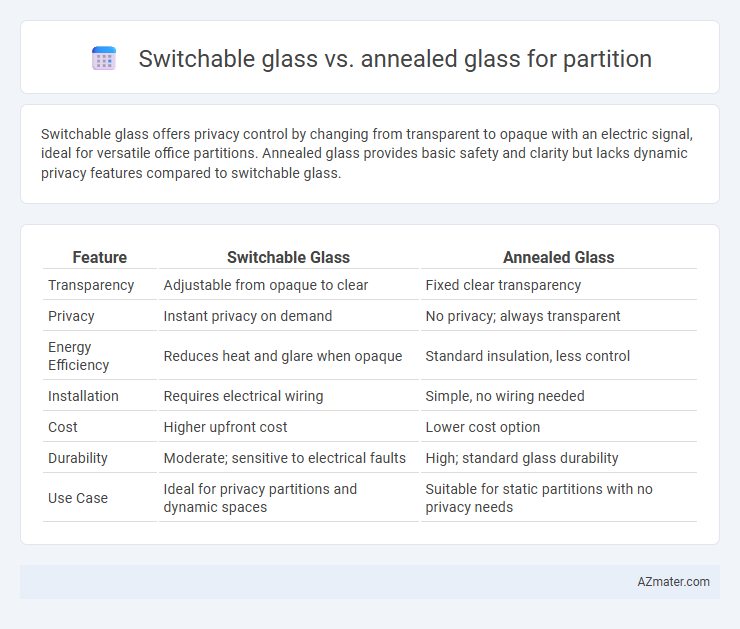Switchable glass offers privacy control by changing from transparent to opaque with an electric signal, ideal for versatile office partitions. Annealed glass provides basic safety and clarity but lacks dynamic privacy features compared to switchable glass.
Table of Comparison
| Feature | Switchable Glass | Annealed Glass |
|---|---|---|
| Transparency | Adjustable from opaque to clear | Fixed clear transparency |
| Privacy | Instant privacy on demand | No privacy; always transparent |
| Energy Efficiency | Reduces heat and glare when opaque | Standard insulation, less control |
| Installation | Requires electrical wiring | Simple, no wiring needed |
| Cost | Higher upfront cost | Lower cost option |
| Durability | Moderate; sensitive to electrical faults | High; standard glass durability |
| Use Case | Ideal for privacy partitions and dynamic spaces | Suitable for static partitions with no privacy needs |
Introduction to Switchable Glass and Annealed Glass
Switchable glass, also known as smart glass, features a technology that allows it to change from opaque to transparent with the application of an electrical current, offering dynamic privacy and light control in partitions. Annealed glass, on the other hand, is a basic form of glass that has been slowly cooled to reduce internal stresses, providing standard clarity and safety but lacking any adjustable transparency. These differences make switchable glass ideal for modern, flexible partition solutions, while annealed glass remains a cost-effective choice for fixed, clear partition installations.
Core Differences Between Switchable and Annealed Glass
Switchable glass integrates a PDLC film that changes from opaque to transparent when electricity is applied, offering dynamic privacy control, while annealed glass is a standard, non-tinted glass that undergoes slow cooling to reduce internal stress but remains static in transparency. Switchable glass provides enhanced functionality for office partitions, enabling instant privacy without physical blinds, whereas annealed glass offers durability and clarity but lacks adjustable light or visibility control. Core differences include the active light modulation in switchable glass versus the passive, uniform transparency of annealed glass, impacting usability, privacy, and price points in partition applications.
Technology Behind Switchable Glass
Switchable glass utilizes embedded liquid crystal technology or suspended particle devices (SPD) that change opacity when an electric current is applied, offering instant privacy control without compromising natural light. Annealed glass, by contrast, is simple heat-treated glass that lacks any dynamic properties and serves primarily as a static partition solution. The technologically advanced switchable glass integrates smart materials and electrical components to provide functionality that cannot be replicated by conventional annealed glass.
Physical Properties of Annealed Glass
Annealed glass exhibits uniform internal stress due to slow cooling during production, resulting in higher flexibility and reduced brittleness compared to tempered or switchable glass. It has a lower strength rating, typically around 45 MPa, and breaks into large, sharp shards rather than granular fragments, posing increased safety risks in partition applications. Its optical clarity and ease of fabrication make it suitable for custom cuts and shapes but less ideal for impact resistance and thermal stress scenarios.
Privacy Benefits: Switchable vs Annealed Glass
Switchable glass offers superior privacy benefits compared to annealed glass by instantly transitioning from transparent to opaque with an electric current, allowing users to control visibility on demand. Annealed glass is transparent and lacks any built-in privacy feature, requiring additional treatments such as films or blinds to maintain privacy. The dynamic opacity of switchable glass makes it an ideal choice for partitions in offices, healthcare, and hospitality settings where privacy needs fluctuate frequently.
Safety and Durability Comparison
Switchable glass incorporates a liquid crystal layer that changes from opaque to transparent with an electrical switch, offering enhanced privacy while maintaining strength comparable to annealed glass. Annealed glass, although durable under normal conditions, is more prone to shattering into sharp shards upon impact, posing higher safety risks in partitions. Switchable glass often uses tempered substrates or laminated layers, significantly improving impact resistance and durability compared to the standard annealed glass commonly used in interior partitions.
Energy Efficiency and Light Control
Switchable glass offers superior energy efficiency by dynamically adjusting light transmission to reduce heat gain and loss, significantly lowering HVAC costs compared to traditional annealed glass. It provides enhanced light control, allowing users to switch from transparent to opaque states, improving privacy without sacrificing natural daylight. Annealed glass lacks this adaptive capability, resulting in less efficient thermal insulation and limited light modulation.
Installation Considerations for Partitions
Switchable glass requires careful electrical wiring integration and a power source during installation, making it slightly more complex than annealed glass partitions, which only need standard framing and mounting. Proper sealing and alignment are critical for switchable glass to ensure consistent operation and avoid electrical faults, whereas annealed glass offers more straightforward handling due to its static properties. Installation of switchable glass also requires compliance with electrical safety standards, whereas annealed glass follows conventional building codes for glass partitions.
Cost Analysis: Switchable Glass vs Annealed Glass
Switchable glass typically costs between $50 to $120 per square foot, significantly higher than annealed glass, which ranges from $8 to $15 per square foot. The higher upfront investment for switchable glass reflects its advanced technology and functionality, such as privacy control and light modulation, whereas annealed glass is favored for its affordability and basic partition applications. Maintenance and energy savings from switchable glass can offset initial costs over time, but annealed glass remains the more cost-effective choice for budget-conscious projects.
Choosing the Right Glass for Your Partition Needs
Switchable glass offers privacy control and energy efficiency by electronically adjusting transparency, making it ideal for modern office partitions requiring dynamic light management. Annealed glass, known for its affordability and strength after slow cooling, suits static partitions where budget and safety are primary concerns. Choosing the right glass depends on balancing factors like privacy, cost, thermal performance, and application-specific durability requirements.

Infographic: Switchable glass vs Annealed glass for Partition
 azmater.com
azmater.com